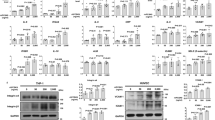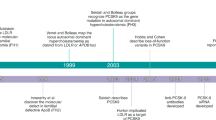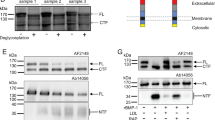Abstract
Proprotein convertase subtilisin kexin type 9 (PCSK9) lowers the abundance of surface low-density lipoprotein (LDL) receptor through an undefined mechanism. The structure of human PCSK9 shows the subtilisin-like catalytic site blocked by the prodomain in a noncovalent complex and inaccessible to exogenous ligands, and that the C-terminal domain has a novel fold. Biosensor studies show that PCSK9 binds the extracellular domain of LDL receptor with Kd = 170 nM at the neutral pH of plasma, but with a Kd as low as 1 nM at the acidic pH of endosomes. The D374Y gain-of-function mutant, associated with hypercholesterolemia and early-onset cardiovascular disease, binds the receptor 25 times more tightly than wild-type PCSK9 at neutral pH and remains exclusively in a high-affinity complex at the acidic pH. PCSK9 may diminish LDL receptors by a mechanism that requires direct binding but not necessarily receptor proteolysis.
This is a preview of subscription content, access via your institution
Access options
Subscribe to this journal
Receive 12 print issues and online access
$189.00 per year
only $15.75 per issue
Buy this article
- Purchase on Springer Link
- Instant access to full article PDF
Prices may be subject to local taxes which are calculated during checkout





Similar content being viewed by others
References
Goldstein, J.L., Hobbs, H.H. & Brown, M.S. Familial hypercholesterolemia. in The Metabolic & Molecular Bases of Inherited Disease (eds. Scriver, C.S. et al.) 2863–2913 (McGraw-Hill, New York, 2001).
Goldstein, J.L. & Brown, M.S. The cholesterol quartet. Science 292, 1310–1312 (2001).
Jeon, H. & Blacklow, S.C. Structure and physiologic function of the low-density lipoprotein receptor. Annu. Rev. Biochem. 74, 535–562 (2005).
Maxwell, K.N. & Breslow, J.L. Proprotein convertase subtilisin kexin 9: the third locus implicated in autosomal dominant hypercholesterolemia. Curr. Opin. Lipidol. 16, 167–172 (2005).
Abifadel, M. et al. Mutations in PCSK9 cause autosomal dominant hypercholesterolemia. Nat. Genet. 34, 154–156 (2003).
Cohen, J.C., Boerwinkle, E., Mosley, T.H., Jr & Hobbs, H.H. Sequence variations in PCSK9, low LDL, and protection against coronary heart disease. N. Engl. J. Med. 354, 1264–1272 (2006).
Lambert, G., Krempf, M. & Costet, P. PCSK9: a promising therapeutic target for dyslipidemias? Trends Endocrinol. Metab. 17, 79–81 (2006).
Dubuc, G. et al. Statins upregulate PCSK9, the gene encoding the proprotein convertase neural apoptosis-regulated convertase-1 implicated in familial hypercholesterolemia. Arterioscler. Thromb. Vasc. Biol. 24, 1454–1459 (2004).
Rashid, S. et al. Decreased plasma cholesterol and hypersensitivity to statins in mice lacking Pcsk9. Proc. Natl. Acad. Sci. USA 102, 5374–5379 (2005).
Brown, M.S. & Goldstein, J.L. Lowering LDL—not only how low, but how long? Science 311, 1721–1723 (2006).
Seidah, N.G. et al. The secretory proprotein convertase neural apoptosis-regulated convertase 1 (NARC-1): liver regeneration and neuronal differentiation. Proc. Natl. Acad. Sci. USA 100, 928–933 (2003).
Seidah, N.G., Khatib, A.M. & Prat, A. The proprotein convertases and their implication in sterol and/or lipid metabolism. Biol. Chem. 387, 871–877 (2006).
Henrich, S., Lindberg, I., Bode, W. & Than, M.E. Proprotein convertase models based on the crystal structures of furin and kexin: explanation of their specificity. J. Mol. Biol. 345, 211–227 (2005).
Benjannet, S. et al. NARC-1/PCSK9 and its natural mutants: zymogen cleavage and effects on the low density lipoprotein (LDL) receptor and LDL cholesterol. J. Biol. Chem. 279, 48865–48875 (2004).
Cameron, J. et al. Effect of mutations in the PCSK9 gene on the cell surface LDL receptors. Hum. Mol. Genet. 15, 1551–1558 (2006).
Henrich, S. et al. The crystal structure of the proprotein processing proteinase furin explains its stringent specificity. Nat. Struct. Biol. 10, 520–526 (2003).
Holyoak, T. et al. 2.4 Å resolution crystal structure of the prototypical hormone-processing protease Kex2 in complex with an Ala-Lys-Arg boronic acid inhibitor. Biochemistry 42, 6709–6718 (2003).
Tangrea, M.A., Bryan, P.N., Sari, N. & Orban, J. Solution structure of the pro-hormone convertase 1 pro-domain from Mus musculus. J. Mol. Biol. 320, 801–812 (2002).
Lagace, T.A. et al. Secreted PCSK9 decreases the number of LDL receptors in hepatocytes and in livers of parabiotic mice. J. Clin. Invest. 116, 2995–3005 (2006).
Naureckiene, S. et al. Functional characterization of Narc 1, a novel proteinase related to proteinase K. Arch. Biochem. Biophys. 420, 55–67 (2003).
Jain, S.C., Shinde, U., Li, Y., Inouye, M. & Berman, H.M. The crystal structure of an autoprocessed Ser221Cys-subtilisin E-propeptide complex at 2.0 Å resolution. J. Mol. Biol. 284, 137–144 (1998).
Zhao, Z. et al. Molecular characterization of loss-of-function mutations in PCSK9 and identification of a compound heterozygote. Am. J. Hum. Genet. 79, 514–523 (2006).
Turk, B. Targeting proteases: successes, failures and future prospects. Nat. Rev. Drug Discov. 5, 785–799 (2006).
Comellas-Bigler, M. et al. 1.2 Å crystal structure of the serine carboxyl proteinase pro-kumamolisin; structure of an intact pro-subtilase. Structure 12, 1313–1323 (2004).
Rudenko, G. et al. Structure of the LDL receptor extracellular domain at endosomal pH. Science 298, 2353–2358 (2002).
Benjannet, S., Rhainds, D., Hamelin, J., Nassoury, N. & Seidah, N.G. The proprotein convertase (PC) PCSK9 is inactivated by furin and/or PC5/6A: functional consequences of natural mutations and post-translational modifications. J. Biol. Chem. 281, 30561–30572 (2006).
Horton, J.D., Cohen, J.C. & Hobbs, H.H. Molecular biology of PCSK9: its role in LDL metabolism. Trends Biochem. Sci. 32, 71–77 (2007).
Kotowski, I.K. et al. A spectrum of PCSK9 alleles contributes to plasma levels of low-density lipoprotein cholesterol. Am. J. Hum. Genet. 78, 410–422 (2006).
Fisher, C., Beglova, N. & Blacklow, S.C. Structure of an LDLR-RAP complex reveals a general mode for ligand recognition by lipoprotein receptors. Mol. Cell 22, 277–283 (2006).
Grozdanov, P.N., Petkov, P.M., Karagyozov, L.K. & Dabeva, M.D. Expression and localization of PCSK9 in rat hepatic cells. Biochem. Cell Biol. 84, 80–92 (2006).
Gabel, B.R. & Koschinsky, M.L. Antifibrinolytic effect of recombinant apolipoprotein(a) in vitro is primarily due to attenuation of tPA-mediated Glu-plasminogen activation. Biochemistry 34, 15777–15784 (1995).
Andreasson, C., Heessen, S. & Ljungdahl, P.O. Regulation of transcription factor latency by receptor-activated proteolysis. Genes Dev. 20, 1563–1568 (2006).
Collaborative Computational Project, Number 4. The CCP4 suite: programs for protein crystallography. Acta Crystallogr. D Biol. Crystallogr. 50, 760–763 (1994).
Acknowledgements
We thank E. Marr, S. Han, D. Brown, A. Panifer, J. Duerr and A. Subashi for technical assistance and I. Wang, B. Chrunyk, F. Rajamohan, P. Hensley, M. Bamberger, C. Hayward, R. Kennedy, J. Thorn, E. Fauman, M.S. Brown and J. Horton for helpful discussions and encouragement.
Author information
Authors and Affiliations
Contributions
M.C.G., T.A.S., A.H.V., M.J.A., L.R.H., K.F.G., D.X., L.C.W., J.L.H., K.M.M., K.J.S.-E. and J.S.C. provided key reagents. D.E.D. and M.N.M. crystallized the protein. X.Q. solved the structure. D.C. performed SPR studies. X.Q., K.F.G., A.P.S. and S.S. wrote the paper.
Corresponding author
Ethics declarations
Competing interests
The authors are employees of Pfizer, which develops and markets medicines to treat cardiovascular disease.
Supplementary information
Supplementary Fig. 1
Structure-based sequence alignments. (PDF 367 kb)
Rights and permissions
About this article
Cite this article
Cunningham, D., Danley, D., Geoghegan, K. et al. Structural and biophysical studies of PCSK9 and its mutants linked to familial hypercholesterolemia. Nat Struct Mol Biol 14, 413–419 (2007). https://doi.org/10.1038/nsmb1235
Received:
Accepted:
Published:
Issue Date:
DOI: https://doi.org/10.1038/nsmb1235
This article is cited by
-
Targeting proprotein convertase subtilisin/kexin type 9 (PCSK9): from bench to bedside
Signal Transduction and Targeted Therapy (2024)
-
Expanding Biology of PCSK9: Roles in Atherosclerosis and Beyond
Current Atherosclerosis Reports (2022)
-
Association of circulating proprotein convertase subtilisin/kexin type 9 concentration, prothrombin time and cardiovascular outcomes: a prospective cohort study
Thrombosis Journal (2021)
-
Patterns and tempo of PCSK9 pseudogenizations suggest an ancient divergence in mammalian cholesterol homeostasis mechanisms
Genetica (2021)
-
Potentiating CD8+ T cell antitumor activity by inhibiting PCSK9 to promote LDLR-mediated TCR recycling and signaling
Protein & Cell (2021)



